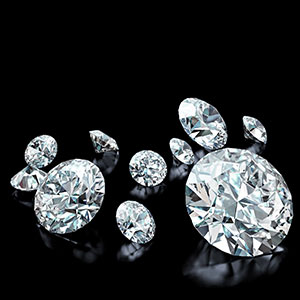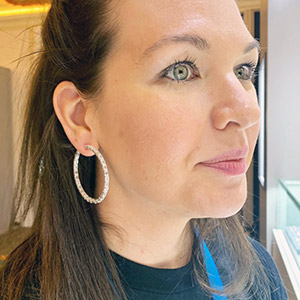
Both the natural and lab-grown diamond sectors are hurting right now, industry members acknowledged at a panel on “The Current State of Diamond Market,” held July 16 during the Initiatives in Art and Culture’s 14th annual Gold + Diamond Conference in New York City.
“Business is quiet for both natural and lab-grown,” said Ronnie Vanderlinden, president of Diamex, which deals in both products. “There’s struggles at the moment. Liquidity is not strong. The U.S. market is the strongest market in the world right now. We hope that by the time September comes around, consumers will wake up and there will be better demand for both natural and lab-grown.”
He noted that Martin Rapaport recently lowered prices on his widely read list.
“They came down for a reason,” he said. “Prices were dropping. They’re not dropping in all categories. They’re actually lifting in certain categories, and staying stable in other categories.”
Matthew Schamroth, partner and CEO of M. Schamroth & Sons diamond company, has also seen a “softening” in the market, but noted that certain items are scarce.
“There’s actually less goods on the wheel today than there has been in a long time,” he said. “So there’s actually a shortage of diamonds in certain sizes and certain shapes, which is healthy given the current environment.”
Olivia Landau, CEO of the Clear Cut, an e-tailer that only sells naturals, said there’s been a silver lining to the fall of natural prices.
“Post-COVID, natural diamond prices went up dramatically,” she said. “Our orders are up, but our [average order value] has stayed the same. With natural diamond prices going back to 2019 levels, we’re seeing a lot of our clients being able to afford what they might not have been able to before. They’re spending the same amount but they’re getting a little bit more.”
Amish Shah, CEO of ALTR, a lab-grown company, said that close to 40 million cts. of lab-grown diamonds will be produced this year and that over 80% of U.S. retailers now offer the product, up from almost none in 2015. He thinks fashion jewelry is a possible growth area for lab-grown.
“What took eight years for the engagement category will take only two years for the fashion category,” Shah predicted.
He maintained the industry is too focused on price.
“It’s important to remember that diamonds are a component, not a finished product,” he said. “The jewel is what the consumer buys. And making margins is not a crime.”
Shah noted that lab-grown diamonds allow for a wider variety of cuts.
“For a client, we are cutting individual teddy bears,” he said. “We do alphabet shapes. It’s a fusion between artistry and technology.”
He also said that the industry should develop more brands.
“People don’t buy socks without looking at the brand,” said Shah. “We have been always tried to sell diamonds without an identity. Branding is key to the future of the industry. The opportunity that both categories have today is design, sustainability, and innovation.”
Russell Kwiat, chief operating officer for Kwiat, a retailer and wholesaler, agreed that the diamond industry needs greater differentiation, which is what his company has focused on.
“Differentiation and branding is not easy to do, but it’s a commitment that we made,” said Kwiat. “We doubled down in a declining environment. Too much of our business is generic and commoditized.”
Landau said branding diamonds “can be done, but it takes a certain education to the consumer, on why they’re paying more for certain diamonds. I think for natural diamonds, that would be about telling that origin story. Consumers are not educated on natural diamond origins. They believe all diamonds are blood diamonds, and they come from one country, which is ‘Africa.'”
Kwiat said some retailers he’s talked to are slowly reemphasizing natural diamonds.
“There was a push element to lab-grown from retailers,” he said. “They got into it for the very good margins, and some of them knew it was a short-term play. They’re now in a place where they do see some of their business is being cannibalized, and they do need to push back toward natural.”
Most of the panelists agreed the current hostilities between natural and lab-grown were not healthy.
“Why are we as an industry not focusing how to grow the diamond and jewelry category, but figuring how to tear each other down or figuring out how to take each other’s share?” asked Shah. “The suffering is on both sides. Why don’t we sit together, and figure how to grow the circle bigger, rather than fight about the nomenclature and everything else?”
Vanderlinden concurred: “The bottom line is we have to work together. Let’s not concentrate on throwing mud. It doesn’t do the category any good. It’s got to stop.”
The panelists did expect the industry to bounce back, as it has in the past.
“History repeats itself,” said Schamroth. “It’s cyclical. Is there a little bit of pain now? Sure. But overall we’re all pretty lucky. We’re involved in something pretty exceptional…. I’ve never seen anyone walk into a jewelry store to buy a diamond and they were angry about it. There’s something really special about it.”
The panel was moderated by the author of this article.
(Photo: Getty Images)
- Subscribe to the JCK News Daily
- Subscribe to the JCK Special Report
- Follow JCK on Instagram: @jckmagazine
- Follow JCK on X: @jckmagazine
- Follow JCK on Facebook: @jckmagazine






